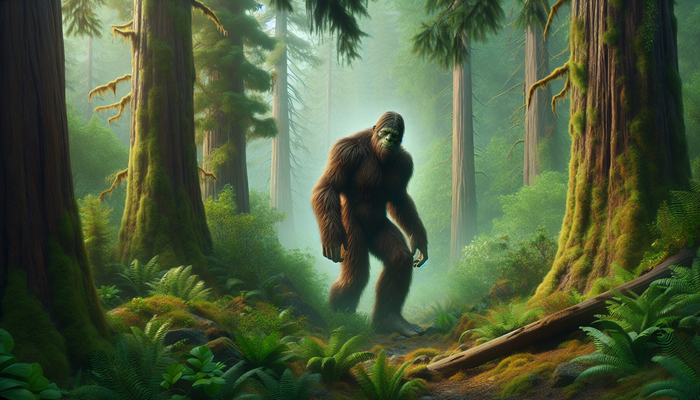Understanding Bigfoot Family Structures: Insights and Dynamics

By Anthony Romano, Cryptozoologist
Cultural Context of Bigfoot Families
The roots of Bigfoot family structures run deep in indigenous narratives across North America. These stories paint a picture not of a lone monster, but of communities of beings with rich social lives. The Salish people of the Pacific Northwest, for instance, speak of "Ts'emekwes," describing creatures that live in family units with distinct roles and responsibilities.
These indigenous tales often highlight nurturing behaviors that mirror human family dynamics. They speak of Sasquatch parents caring for their young, teaching them survival skills, and maintaining close-knit family bonds. This cultural context provides a foundation for understanding Bigfoot not as a solitary wanderer, but as a creature deeply embedded in familial and social structures.
As European settlers arrived in North America, they brought their own folklore of wild men and forest dwellers. These stories merged with indigenous narratives, evolving into the modern Sasquatch mythos. This blending of cultural perspectives has shaped our current understanding of Bigfoot family structures, infusing them with both ancient wisdom and contemporary interpretation.
Observational Studies on Bigfoot Family Dynamics
Recent years have seen a surge in systematic attempts to study Bigfoot behavior in the wild. These observational studies, often conducted over several years in remote forest areas, have yielded intriguing insights into Sasquatch social structures.
One particularly comprehensive study, carried out over five years in the dense forests of the Pacific Northwest, utilized a range of observational techniques. Researchers employed everything from high-powered binoculars and night vision equipment to sophisticated audio recording devices. Their goal was to capture any evidence of Bigfoot activity without disturbing potential habitats.
The findings from these studies suggest that Bigfoot families exhibit complex social structures comparable to those of known primate species. Typically, a family unit consists of a dominant male, one or more adult females, and their offspring. This hierarchical structure mirrors that of many great apes, where the dominant male often takes on the role of protector and leader.
Females, according to these observations, play a crucial role in nurturing and educating the young. This division of responsibilities indicates a level of social organization that goes beyond mere survival instincts, hinting at a sophisticated family dynamic.
Communication within these family groups appears to be multifaceted and nuanced. Researchers have recorded a variety of vocalizations, including whoops, whistles, and low-frequency growls. These sounds seem to serve different purposes, from alerting family members to potential dangers to coordinating group movements.
Beyond vocalizations, Bigfoot families appear to use a range of gestures and possibly even olfactory signals to communicate. This complex communication system suggests a level of intelligence and social awareness that challenges our preconceptions about these creatures.
Parenting and Nurturing Behaviors
One of the most fascinating aspects of Bigfoot family life is the apparent dedication to parenting and nurturing behaviors. Observations indicate that Sasquatch mothers, in particular, play a pivotal role in raising and educating their young.
Young Sasquatches are often seen in close proximity to their mothers, learning essential survival skills. These lessons include foraging techniques, navigation through difficult terrain, and possibly even the construction of shelters. The time and effort invested in this education process speak to a long-term commitment to offspring survival, a trait common in highly intelligent species.
Play behavior among juvenile Sasquatches offers another window into their social development. Researchers have observed young Bigfoot engaging in activities that closely resemble the play of other primate species. These include mock wrestling, chasing games, and even rudimentary forms of hide-and-seek.
Such play serves multiple purposes beyond mere entertainment. It helps young Sasquatches develop crucial motor skills, enhances their problem-solving abilities, and strengthens social bonds within the family group. The presence of structured play activities suggests a level of cognitive development that aligns with other highly social primates.
Interestingly, some researchers have noted what appears to be shared childcare responsibilities within Bigfoot groups. While mothers take on the primary caregiving role, other adult members of the group have been observed interacting with and watching over young Sasquatches. This communal approach to child-rearing is reminiscent of some human societies and certain great ape species, further highlighting the complex social structures within Bigfoot families.
Nesting and Shelter Construction
One of the most compelling pieces of evidence for Bigfoot family structures comes in the form of elaborate nesting sites discovered in remote wilderness areas. These constructions, often referred to as "Bigfoot nests," offer tantalizing clues about Sasquatch family life and intelligence.
Typical Bigfoot nests are large, circular or oval-shaped structures made primarily from interwoven sticks and branches. Their size is impressive, often measuring 8 to 10 feet in length and 4 to 5 feet in width. This makes them significantly larger than the average human bed and too large for most known forest animals.
The construction of these nests showcases a remarkable level of craftsmanship. Sticks and branches are not merely piled haphazardly but carefully interlocked and woven together. This creates a sturdy, almost basket-like structure that can withstand the elements. The interior often contains a clear, body-sized impression, suggesting its use as a resting place for a large creature.
What sets these nests apart from those of known animals is their complexity and apparent planning. Bears, for instance, are known to create simple beds from forest debris, but these pale in comparison to the intricate designs attributed to Bigfoot. The level of manual dexterity required to construct these nests suggests a creature with significant cognitive abilities and opposable thumbs.
The location of these nests also provides insights into Bigfoot family life. They are often found in clusters, suggesting that family groups may sleep in close proximity to one another. Some researchers have even reported finding what appear to be smaller nests near larger ones, potentially indicating separate sleeping areas for adults and young.
The consistent design and construction of these nests across different regions hint at a cultural practice among Sasquatch populations. This implies a form of knowledge transfer from one generation to the next, a hallmark of intelligent, social species. The idea that Bigfoot might have cultural traditions passed down through families adds another layer of complexity to our understanding of these creatures.
However, it's important to note that the attribution of these nests to Bigfoot remains controversial. Skeptics argue that they could be the work of other animals or even human hoaxers. The lack of direct observation of a Sasquatch constructing or using these nests leaves room for debate. Nonetheless, the sheer number of these structures found in remote areas, often far from human activity, continues to fuel speculation about their origin.
Territorial Behavior and Family Defense
Understanding how Bigfoot families interact with their environment and other creatures provides crucial insights into their social dynamics. Observational studies and folklore alike suggest that Sasquatch groups exhibit strong territorial behaviors, much like other large primates.
One of the most commonly reported signs of Bigfoot territorial marking is tree breaking. This involves snapping or twisting trees, often at heights that would be difficult for humans to reach without tools. These broken trees are thought to serve as boundary markers, warning other Sasquatch families or potential predators to keep their distance.
Ground scraping is another behavior associated with Bigfoot territoriality. Large areas of forest floor are sometimes found cleared of debris, with deep furrows scratched into the soil. Some researchers speculate that these areas might serve as gathering places for Bigfoot families or as visual markers of territory boundaries.
Interestingly, while territorial behaviors are common, outright aggressive encounters between Bigfoot groups seem to be rare. When territorial disputes do occur, they often involve displays of strength and vocalizations rather than physical confrontations. This mirrors the behavior of many great ape species, where conflict is often resolved through intimidation rather than violence.
The defense of family members, particularly young Sasquatches, appears to be a priority for adult Bigfoot. There are numerous accounts in folklore and some observational reports of adult Sasquatch placing themselves between perceived threats and younger members of their group. This protective behavior further underscores the strong family bonds within Bigfoot social structures.
The Role of Bigfoot Families in Ecosystems
The presence of Bigfoot families, if confirmed, would have significant implications for our understanding of forest ecosystems. As large, intelligent primates, Sasquatch would likely play a crucial role in their habitats, influencing everything from plant dispersal to prey populations.
Some researchers have noted areas where Bigfoot activity is suspected to have unusual patterns of vegetation growth or disturbance. This could indicate that Sasquatch families actively shape their environment, perhaps creating clearings for gatherings or encouraging the growth of preferred food plants.
The diet of Bigfoot families is a subject of much speculation. Based on folklore and some observational evidence, Sasquatch are thought to be omnivorous, consuming a wide variety of plant materials as well as small animals. This diverse diet would place them in competition with other forest omnivores like bears, potentially influencing the ecological balance of their habitats.
Interestingly, some wildlife biologists have noted unusual behavior in prey species in areas of reported Bigfoot activity. Deer, for instance, have been observed exhibiting heightened alertness or avoiding certain areas altogether. While this could be attributed to many factors, some researchers speculate that it could be a response to the presence of a large, unknown predator.
The potential ecological role of Bigfoot families extends beyond their immediate impact on flora and fauna. If these creatures do indeed exist, they would represent a significant biomass in forest ecosystems. Their foraging, nesting, and other activities would contribute to nutrient cycling and habitat modification on a scale that could have far-reaching effects on forest health and biodiversity.
Modern Interpretations and Cultural Impact
The concept of Bigfoot families has captured the public imagination, influencing everything from popular culture to conservation efforts. Films like "Sasquatch Sunset" and "Bigfoot Family" have brought the idea of Sasquatch as social, family-oriented beings to mainstream audiences. These portrayals, while fictional, reflect a growing interest in exploring the more nuanced aspects of Bigfoot lore.
These media representations often emphasize Bigfoot's connection to nature and family, fostering a sense of empathy and curiosity among audiences. This shift in portrayal from a solitary monster to a creature with complex social bonds has had a significant impact on how the public perceives the possibility of Bigfoot's existence.
Interestingly, the concept of Bigfoot families has been embraced by some environmental organizations as a tool for conservation messaging. The idea of protecting forests not just for known species, but for the possibility of undiscovered creatures like Sasquatch, has proven to be a powerful motivator for some conservation efforts.
The cultural impact of Bigfoot family structures extends to tourism as well. Many regions with strong Sasquatch traditions have developed Bigfoot-themed attractions, often emphasizing the family-friendly nature of these legendary creatures. This has led to a unique form of crypto-tourism, where enthusiasts can explore purported Bigfoot habitats while learning about local ecosystems and conservation efforts.
Skepticism and the Need for Further Research
Despite the wealth of anecdotal evidence and the cultural significance of Bigfoot family structures, the scientific community remains largely skeptical of their existence. The lack of conclusive physical evidence, such as bodies or clear photographic proof, continues to be a significant hurdle in establishing the reality of Sasquatch.
Critics argue that many of the behaviors and structures attributed to Bigfoot families can be explained by known animals or natural phenomena. The nests, for instance, are sometimes attributed to bear activity or even elaborate hoaxes. Footprints and other physical signs are often dismissed as misidentifications or fabrications.
However, proponents of Bigfoot research argue that the consistency of reports across different regions and cultures, combined with the complexity of the behaviors observed, warrants further scientific investigation. They point out that many species were once considered mythical before being officially discovered, and that the vast wilderness areas of North America could potentially harbor an undiscovered primate species.
The debate surrounding Bigfoot family structures highlights the need for rigorous, scientific approaches to cryptozoology. Advanced technologies like environmental DNA analysis, thermal imaging, and long-term camera traps offer new possibilities for gathering evidence. These methods, combined with traditional field research and anthropological studies, could provide new insights into the possibility of Sasquatch families.
Regardless of one's stance on the existence of Bigfoot, the study of these purported family structures offers valuable lessons in ecology, anthropology, and the human relationship with the natural world. The enduring fascination with Sasquatch speaks to our deep-seated curiosity about the unknown and our connection to the wilderness that still exists in our world.
As we continue to explore the mysteries of Bigfoot family structures, we open ourselves to new possibilities and perspectives. Whether Sasquatch exists or not, the quest to understand these elusive creatures enriches our understanding of the natural world and our place within it. The story of Bigfoot families, with its blend of ancient folklore and modern scientific inquiry, remains a testament to the enduring power of mystery and the human drive to understand the world around us.
From Bigfoot to UFOs: Hangar 1 Publishing Has You Covered!
Explore Untold Stories: Venture into the world of UFOs, cryptids, Bigfoot, and beyond. Every story is a journey into the extraordinary.
Immersive Book Technology: Experience real videos, sights, and sounds within our books. Its not just reading; its an adventure.



























